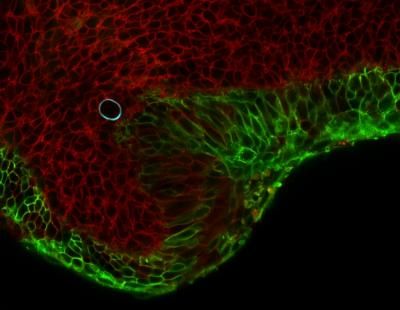This is how highly resistant strains of fungi emerge
Antibiotic resistance is a matter of common knowledge. And the same phenomenon also occurs with drugs against pathogenic fungi. What causes it is still not very well understood.

© Chaoyang Xue, Kasey Carroll, and Joseph Heitman (Duke University Department of Molecular Genetics and Microbiology); and Valerie Knowlton (North Carolina State University, Center for Electron Microscopy)
An international research team has deciphered the mechanism by which the fungus Cryptococcus neoformans is resistant to fungus-specific drugs. It is a yeast-like fungus that can infect humans. Specific drugs, named antifungals, are available for treatment, but they don’t always work – a phenomenon similar to antibiotic resistance. A team from Duke University in the USA and Ruhr-Universität Bochum (RUB) has used genetic, bioinformatic and microbiological techniques to decipher the mechanism underlying this resistance.
“The results are highly relevant for combating fungal infections in clinical practice, veterinary medicine and agriculture,” says Professor Ulrich Kück, Senior Professor in General and Molecular Botany at RUB. He cooperated for the project with the Bochum researcher Dr. Tim Dahlmann and the team headed by Professor Dr. Joe Heitman, who is currently based at Duke University in North Carolina and has been a visiting professor at RUB on several occasions.
Number of fungal infections on the rise
“In the western hemisphere, the number of people with a lowered immune defence is increasing, because life expectancies are rising rapidly and treatment with immunosuppressants after organ transplants is becoming more common,” explains Ulrich Kück. “This is associated with an increase in fungal infections.” Cryptococcus neoformans is one of the most significant human pathogenic fungi responsible for so-called cryptococcosis. It triggers acute infections in immunocompromised patients; and the mortality rate may be as high as 70 per cent. This is because fungal strains that are resistant to the drugs often evolve in hospitals, which makes treatment more difficult. So far, it was unclear which cellular and genetic mechanisms lead to this resistance.
So-called transposons, however, were known to play a role in the resistances. Transposons are jumping genes, i.e. DNA segments that can change their position in the genome and thus affect the function of genes. If a transposon jumps into a gene that’s critical for susceptibility to a drug, it’s possible for resistance to emerge. The mobility of the transposons is controlled by regulatory RNAs, so-called small interfering RNA, or siRNA for short.
RNA mechanism causes resistance
In their current study, the researchers discovered gene mutations in resistant isolates that led to siRNA control being switched off. By introducing an intact copy of the gene, it was possible to restore siRNA control; as a result, the researchers were able to prevent the transposons from jumping and shed light on the cause of resistance. Due to their small size, the gene segments that code for siRNAs are not easy to find in the genome. Tim Dahlmann managed to locate them with special bioinformatic analyses. By identifying the resistance mechanisms, it will be possible to use them for the treatment of mycoses in humans in the future.
Original publication
Most read news
Original publication
Shelby J. Priest, Vikas Yadav, Cullen Roth, Tim A. Dahlmann, Ulrich Kück, Paul M. Magwene, Joseph Heitman: "Uncontrolled transposition following RNAi loss causes hypermutation and antifungal drug resistance in clinical isolates of Cryptococcus neoformans."; Nature Microbiology, 2022.
Topics
Organizations
Other news from the department science

Get the life science industry in your inbox
By submitting this form you agree that LUMITOS AG will send you the newsletter(s) selected above by email. Your data will not be passed on to third parties. Your data will be stored and processed in accordance with our data protection regulations. LUMITOS may contact you by email for the purpose of advertising or market and opinion surveys. You can revoke your consent at any time without giving reasons to LUMITOS AG, Ernst-Augustin-Str. 2, 12489 Berlin, Germany or by e-mail at revoke@lumitos.com with effect for the future. In addition, each email contains a link to unsubscribe from the corresponding newsletter.
Most read news
More news from our other portals
Last viewed contents

May the cellular force be with you - UC Santa Barbara assistant professor Otger Campas is one of the minds behind a new method for measuring the cellular forces that shape tissues and organs

Most powerful dual-comb spectrometer developed - System paves the way for many applications

Gene editing via CRISPR/Cas9 can lead to cell toxicity and genome instability - Researchers identify critical spots on the genome where gene editing could cause an unwanted response, and they provide recommendations for safer approaches
KDR Biotech markets DASGIP Parallel Bioreactor Systems in Korea

How cells rewrite their fate - The study could be the starting point for new methods to alter the molecular mechanisms of cancer development
Meige's_syndrome

Ready. Get set. Repress! - Stowers scientists manipulate the Set2 pathway to show how genes are faithfully copied
Superior_olivary_complex
BRAF-mutant mCRC phase III trial initiated - Merck partners with Array BioPharma and Pierre Fabre
On_the_Origin_of_Species






















































